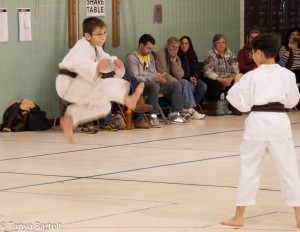The martial arts are often thought of when parents want their children to learn discipline. This is a skewed view of what is actually taught. The martial arts teaches self discipline that the student uses to empower their life. It isn’t the same thing!
 There are regular calls to martial arts schools, usually from mothers, asking if they will take a 4 year old, a 5 year old or a 6 year old because they have anger issues and need to develop discipline. These ages don’t learn “martial arts”. It is much more like organized play. They learn physical education concepts like balance, coordination and gross motor skills and they may resent being forced to go to class and treat it as a punishment preventing learning.
There are regular calls to martial arts schools, usually from mothers, asking if they will take a 4 year old, a 5 year old or a 6 year old because they have anger issues and need to develop discipline. These ages don’t learn “martial arts”. It is much more like organized play. They learn physical education concepts like balance, coordination and gross motor skills and they may resent being forced to go to class and treat it as a punishment preventing learning.
In addition to developing physically, they will start to develop self discipline. Because they choose to participate, these younglings will choose to stand still or do activities when asked. This is self discipline. They see the reward or outcome as something they desire. This desire allows them to focus and control what they are doing to create respectful and appropriate behavior. This happens for all students. Each one chooses to act according to how they are instructed and asked to attain goals that they view as worthwhile. Although most instructors can tell when it is “Fake Discipline” too!
What has been lost over time is the way in martial arts marketing is the inclusion of the word “self” when mentioning the benefits of training. The phrases used to describe the benefits of martial arts training had been self-discipline, self-control and self-esteem. All of these refer to something that you develop within yourself. This is done by focusing on the requirements and committing to the hard work needed to development them.
The twist here is that all of these come from an internal source Discipline taught at a military school uses externally enforced activity, where self discipline is developed internally. Once developed, the student can see better how their skills and knowledge can serve the family, community, nation. They’ve developed characteristics beyond those listed above, which now include respect, loyalty, dedication and hard work. Parents understand this concept because they’ve had to develop work habits and gain knowledge about working within a company and community. They forget that the role models used during their childhood was probably very different from the one’s around today.
The societal change to two income families hasn’t helped either. Having a parent home after school to teach younglings to “work with” them to accomplish chores and tasks created the discipline within the family. Growing up with respect and loyalty to their parents, grandparents and other relatives built the foundation that helped lead to their own self-respect and self-discipline. Much of this is lacking in homes today. Younglings are allowed to misbehave without correction from parents (for which ever reason) and often have using television and computers as a proxy to proper interaction. These are just a few thoughts behind why I typically take age 8 & up in Taekwondo and 12 & up in Haidong Gumdo. There are exceptions but mainly because a parent is also joining class. Also, if you ask any of my younglings, “Are there any kids in class?” They will answer you, “No, there are only students.” A question that I will ask often during class is “How many times should you be asked to do something?” They all, even the adults, know the answer is “Once.” The parents that are active with their child’s training hears this and knows what they should expect at home. The whole key to any of this, though, is that the youngling has to CHOOSE to work toward developing any of this knowledge and these skills. Discipline is not something that can be magically created within someone without their choosing to allow that growth.
“[…] It is through these habits that the young become old and kingly warriors.” ~ Instructions of Cormac
![]()

